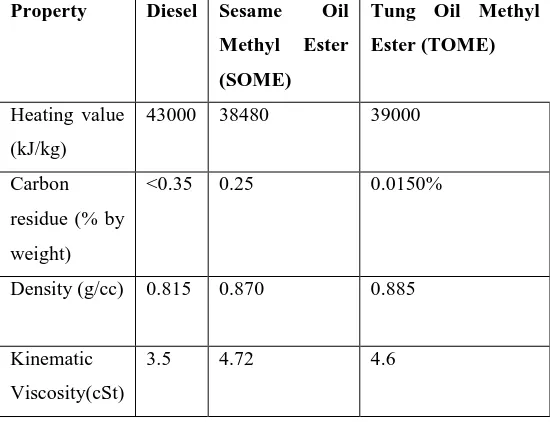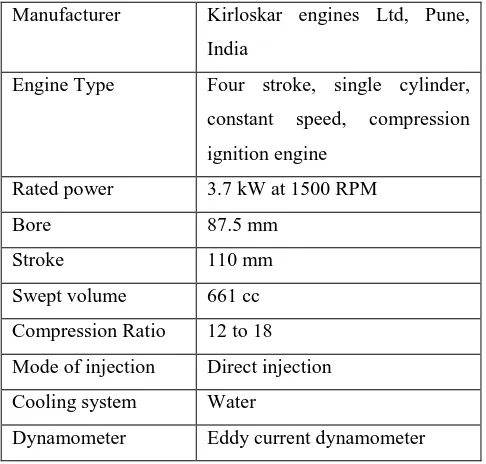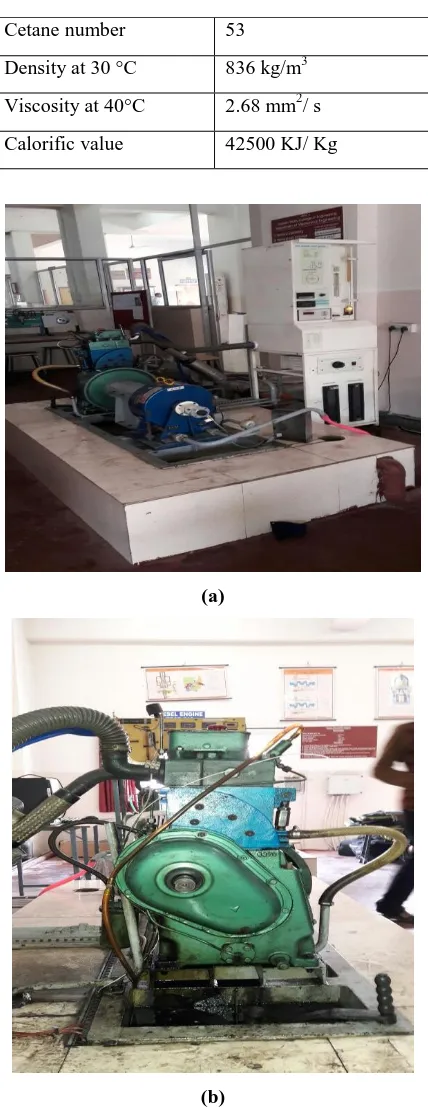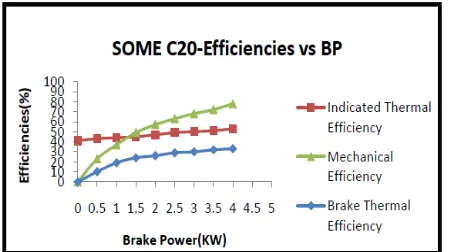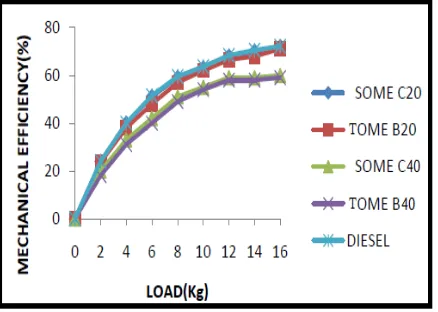BIODIESEL PRODUCTION FROM SESAME OIL AND
TUNG OIL AND DETERMINATION OF ITS EFFECTS
ON PERFORMANCE AND EMISSIONS OF A CI
ENGINE
Subhash L.Gadhave
1,Satishchandra S.Ragit
2 1Ph.D. Research Scholar,
2Ph.D. Research Co-guide
Shri JJT University, Jhunjhunu, Rajasthan, India
ABSTRACT
In today’s world various source of energy are given importance because of gradual depletion of fossil fuels
reserves vegetable oils can be used as an alternative to diesel in CI engines. The utilization of vegetable oils in
CI engine results in low CO and HC emissions compared to conventional diesel fuel. This study covers the
various aspects of biodiesels fuel derived from sesame & tung oil. Sesame & Tung oil is converted to Sesame &
Tung oil methyl esters by transesterification process. An experimental investigation was carried out on
C.I.engine with Bio Diesel blends of sesame oil methyl Esters and tung oil methyl Esters. The engine used for
the experiments was single cylinder Four Stroke water cooled, constant speed diesel engine. Sesame oil methyl
ester (SOME) and Tung oil methyl ester (TOME) are derived through transesterification process and
parameters of transesterification were optimized. The blends of various proportions of the SOME &TOME with
diesel were prepared, analyzed and compared with diesel fuel, and comparison was created to suggest the
better choice among the bio diesel. Various tests have been carried out to examine properties, performance of
various blends (S20, S40, S60, and S80) of SOME and TOME as compared to diesel. From the experimental
results it is indicated that S20 have closer performance to diesel. However, its diesel blends showed affordable
efficiencies. From the experimental results it is observed that sesame oil methyl ester gives better performance
compared to oil methyl esters and also the emissions and smoke for these diesel blends are less as compare to
the pure diesel.
Keywords— Bio-diesel, Properties, Transesterification, Optimization, Sesame Oil Methyl Ester
(SOME), Tung Oil Methyl Ester (TOME)
I. INTRODUCTION
causing environmental pollution. Of the available energy, the current energy utilization pattern is heavily biased for meeting the high energy demand in urban and cosmopolitan cities. There are different types of Biodiesels are available corresponding to sunflower, Soyabean, Cottonseed, Linseed, Mahua, Jatropha, Pongamia, Sesame, Tung etc .[3]. The vegetable oils are often utilized in diesel engines by various techniques corresponding to fuel modifications by Transesterification , Diesel Vegetable blends and vegetable oil heating etc.[4]. The current work has to research the evolution of Sesame and Tung oils with Diesel. Experiments were carried out at constant speed 1500 rpm and at completely different loads with different blends.
1.1
Fuel Modification
1.1.1 Transesterification
Transesterification process is the reaction of vegetable oil or animal fat with a presence of alcohol, in most cases methanol, to form esters and glycerol. The transesterification reaction is affected by alcohol type, molar ratio of glycerides to alcohol, type and amount of catalyst, reaction temperature, reaction time and free fatty acids and water content of vegetable oils or animal fats. The transesterification reaction proceeds with or without a catalyst by using primary or secondary monohydric aliphatic alcohols having 1–8 carbon atoms as follows: Triglycerides + Alcohol Glycerin + Mono-alkyl esters.
Generally, the reaction temperature near the boiling point of the alcohol is recommended. Nevertheless, the reaction may be carried out at room temperature. The reactions take place at low temperatures (~65°C) and at modest pressures (2 atm, 1 atm = 101.325 kPa). Bio-diesel is further purified by washing and evaporation to remove any remaining methanol. The oil (87%), alcohol (9%), and catalyst (1%) are the inputs in the production of bio-diesel (86%), the main output. Pre-treatment is not necessary if the reaction is carried out under high pressure (9000 kPa) and high temperature (~240°C), where simultaneous esterification and transesterification take place with maximum yield obtained at temperatures ranging from 60 to 80°C at a molar ratio of 6:1. The alcohols utilized in the transesterification are usually short chain alcohols such as methanol, ethanol, propanol, and butanol. It was reported that when transesterification of soybean oil using methanol, ethanol and butanol was performed, 96–98% of ester could be obtained after 1 h of reaction.
Table 1. Properties of Diesel and Crude Oils
S.No. PROPERTY DIESE
L
SESAME
OIL
TUNG
OIL
1 Calorific Value (kJ/kg)
43,000 39480 35810
2 Flash Point (°C) 44 345 322
3 Fire Point(°C) 49 360 345
4 Viscosity 0.278
poise
35.5 at 38°C 121.74 at 40°C
Table 1.1 Blending percentage of Sesame oil
NOTATION FUEL
QUANTITY (Litres) BIO-DIESEL QUANTITY (ml) DIESEL QUANTITY (ml)
SO20 1 200 800
SO40 1 400 600
SO60 1 600 400
SO80 1 800 200
Table 1.2 Blending percentage of Tung oil
NOTATION FUEL
QUANTITY (Litres) BIO-DIESEL QUANTITY (ml) DIESEL QUANTITY (ml)
TO20 1 200 800
TO40 1 400 600
TO60 1 600 400
TO80 1 800 200
Table 1.3 Properties of Pure Diesel, Sesame oil Methyl Ester with Tung Oil Methyl Ester
Property Diesel Sesame Oil
Methyl Ester
(SOME)
Tung Oil Methyl
Ester (TOME)
Heating value (kJ/kg)
43000 38480 39000
Carbon residue (% by weight)
<0.35 0.25 0.0150%
Density (g/cc) 0.815 0.870 0.885
Kinematic Viscosity(cSt)
3.5 4.72 4.6
II. EXPERIMENTAL SET UP
load cell. The eddy current dynamometer is used to feed load to the system. The In-cylinder pressure was measured by piezoelectric pressure transducer built-in on the engine cylinder head. A crank angle encoder be situated to sense the crank position. Exhaust gas analyser was executed using five gas exhaust analyzer (AVL make). AVL 437 smoke meter was attached to exhaust pipe to measure smoke levels.
Fig.1 Experimental set-up of VCR Engine
Table 2: Engine specifications
Manufacturer Kirloskar engines Ltd, Pune, India
Engine Type Four stroke, single cylinder, constant speed, compression ignition engine
Rated power 3.7 kW at 1500 RPM
Bore 87.5 mm
Stroke 110 mm
Swept volume 661 cc Compression Ratio 12 to 18 Mode of injection Direct injection Cooling system Water
Dynamometer Eddy current dynamometer
2.1 Fuel Property Measurement
Table 3: Properties of diesel fuel
Cetane number 53
Density at 30 °C 836 kg/m3 Viscosity at 40°C 2.68 mm2/ s Calorific value 42500 KJ/ Kg
(a)
(b)
Fig: 2 (a) 4- Stroke diesel engine (b) Dynamometer
III. PERFORMANCE
different blends of the SOME and TOME with Diesel were prepared, analyzed and compared with diesel fuel, and comparison was made to recommend the better possibility among Bio Diesel blend, but its Diesel blends showed affordable efficiencies. different engine performance parameters like Brake Power, Brake Thermal efficiency, BSFC, IP, CV, Mechanical efficiency etc. were determined and results were plotted with respect to load.
Fig. 3: Variations of SOME C20-BSFC, ISFC v/s BP
Fig 4: Variations of SOME B20-EFFICIENCIES v/s BP
IV. RESULTS AND DISCUSSION
From the results obtained from experiments of Diesel and its blends the graphs were plotted with respect to load.
5.1 Fuel Consumption
The fuel consumption characteristics of an engine are generally expressed in terms of specific fuel consumption in kilograms of fuel per kilowatt-hour. It is an important parameter that reflects how good the engine performance is. It is inversely proportional to the thermal efficiency of the engine.
Fig 5: Variations of BSFC v/s Load of SOME & TOME blends with Diesel
From the above plot, it is observed that the brake specific fuel consumption (BSFC) for SOME and TOME with Diesel are decreasing and these blends were giving better values as compared to the diesel fuel.
Fig 5: Variations of Brake Thermal Efficiency v/s Load of SOME & TOME with Diesel
From the plot, it is indicated that the Brake Thermal efficiencies of SOME and TOME are slightly higher values as compared the Diesel because of complete combustion.
From the plot it is observed that Mechanical efficiency in case of Diesel with SOME & TOME blends has been found that the mechanical efficiency is on par when compared to Diesel but a slight drop of efficiency was found with methyl esters (bio-diesel) when compared with diesel. This drop in thermal efficiency must be attributed to the poor combustion characteristics of methyl esters due to high viscosity. It was observed that the brake thermal efficiency of SO20 and SO40 are very close to brake thermal efficiency of diesel. SO20 methyl ester had equal efficiency with diesel. Hence SO20 can be suggested as best blend for bio-diesel preparation.
V. CONCLUSION
In the current investigation, it has confirmed that SESAME and TUNG oil may be used as resource to obtain the bio diesel. The methyl esters of Sesame and Tung oil along with diesel may reduce the environmental impacts of transportation and also reduce the dependency on crude oil imports, and also provide employments in agricultural field. The conclusions are summarized as follows.
There was increase in Brake Thermal Efficiency of SOME –S020 as compared to Pure Diesel because
of complete combustion.
It was observed that the smoke and emissions for the blends of SOME and TOME are less as compared
to Pure Diesel.
Properties of the 20% blend of SOME are nearer to the Diesel Fuel.
Thus the above investigations suggest that blend of SOME – S020 is the optimum blend which can
produce better values with Pure Diesel for Diesel engines as far as performance and emissions were considered.
REFERENCES
[1] K. Purushothaman, G. Nagarajan in Performance, emission and combustion characteristics of a compression ignition engine operating on neat orange oil, Renewable Energy 34 (2009) 242–245 [2] T. Elanga, T. Senthilkumar in Performance and Emission Characteristics on CI Engine Fuelled with
non-edible vegetable oil and diesel blends, Journal of Engineering Science and Technology Vol. 6, No. 2 (2011) 240 – 250
[3] Y.D. Wang, T. Al-Shemmeri, P. Eames , J. McMullan, N. Hewitt, Y. Huang, S. Rezvani in An experimental investigation of the performance and gaseous exhaust emissions of a diesel engine using blends of a vegetable oil, Applied Thermal Engineering 26 (2006) 1684–1691
[4] Bureau of Energy Efficiency given report on present day energy scenario includes the energy consumption, needs and shortage in energy, various international treaties such as Kyto Protocol and other information
[5] R.V. SHAHI, Secretary, Government of India, Ministry of Power presenting a report on the present energy needs of India in terms of coal, mineral oil, natural gas and government initiatives for utilization of biomass
(COP), Clean Development Mechanism (CD M), Prototype Carbon Fund (PCF), Sustainable Development.
[7] Srinivasa rao. P, Goplalakrishna KV. ―Esterified oils as fuels in diesel engines‖, 11th National conference on IC Engines, IIT Madras, India, 1983.
[8] Tomasevic AV, Marinkovic SS ―Methanolysis of used frying oil‖. Fuel process technology 2003; 81:1-6.
[9] A.S Ramadhas, S.Jayaraj, C Muraleedharan, ―use of vegetable oils as IC engine fuels A review, Renewable energy‖, Vol.29,203,727-742.
[10] Canakci and Vam Geroen (2003) ―A pilot plant to produce biodiesel form high free fatty acid feedstock‖, American society of agricultural engineers, 46(4), PP: 945-954
[11] Jon H. Van Gerpen, Charles L. Peterson, Carroll E. Goering, Biodiesel: An Alternative Fuel for Compression Ignition Engines, for presentation at the 2007 Agricultural Equipment Technology Conference Louisville, Kentucky, USA 11-14 February 2007.
[12] ASTM. 2002. D 6751 – Standard specification for biodiesel fuel (B100) blend stock for distillate fuels. West Conshohocken, Penn: ASTM International..
[13] Rupinder Sing, Biodiesel Production from Jatropha (Source- Kurukshetra, volume-55, No-4, February- Prof. (Dr.) R. K. Khotoliya, Dr. Harminder Kaur &2007).
[14] Knothe, G. 2005b. Cetane numbers—the history of vegetable oil-based diesel fuels. Chapter 2 in G. Knothe, J. Van Gerpen, and J. Krahl, eds. The Biodiesel Handbook. Champaign, Ill.: American Oil Chemists’ Society Press.
[15] Peterson, C.L. 1980. Vegetable oils—Renewable fuels for diesel engines. ASAE Paper No. PNW 80- 105. St. Joseph, Mich.: ASAE.

